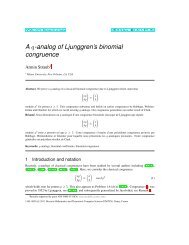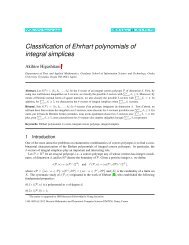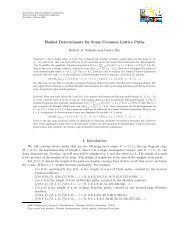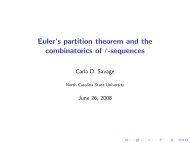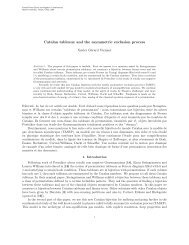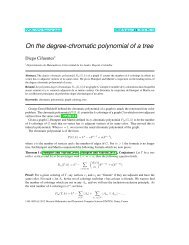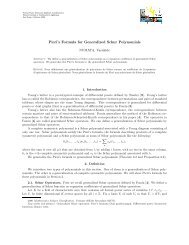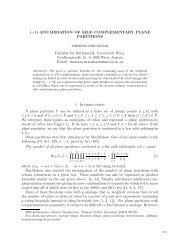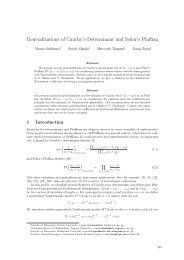Polynomial functions on Young diagrams arising from bipartite graphs
Polynomial functions on Young diagrams arising from bipartite graphs
Polynomial functions on Young diagrams arising from bipartite graphs
You also want an ePaper? Increase the reach of your titles
YUMPU automatically turns print PDFs into web optimized ePapers that Google loves.
<str<strong>on</strong>g>Polynomial</str<strong>on</strong>g> <str<strong>on</strong>g>functi<strong>on</strong>s</str<strong>on</strong>g> <strong>on</strong> <strong>Young</strong> <strong>diagrams</strong> 267<br />
Fig. 3: Example of a c<strong>on</strong>structi<strong>on</strong> of a map and its subtree ( ˜M, ˜T ) (<strong>on</strong> the right) <strong>from</strong> a given map with its<br />
subtree (M, T ) (<strong>on</strong> the left), such that ˜M/ ˜T = M/T . Face type of maps is given by µ = (12). As<br />
pair-partiti<strong>on</strong>s we have M = {{1, 7}, {2, 3}, {4, 6}, {5, 11}, {8, 9}, {10, 12}}, T = {{2, 3}, {8, 9}}, ˜M =<br />
{{1, 7}, {2, 8}, {3, 9}, {4, 6}, {5, 11}, {10, 12}}, ˜T = {{2, 8}, {3, 9}}.<br />
Definiti<strong>on</strong> of N gives us property (iii) immediately. Property (i’) can be shown, as it was menti<strong>on</strong>ed in<br />
Secti<strong>on</strong> 1.5, by proving that if we change <str<strong>on</strong>g>functi<strong>on</strong>s</str<strong>on</strong>g> N <strong>on</strong> the right hand sides of (4) and (5) by some other<br />
<str<strong>on</strong>g>functi<strong>on</strong>s</str<strong>on</strong>g> Ñ which count ‘injective embeddings’, the equalities will still hold. The proof of that will be<br />
the same as in Féray and Śniady (2011b), hence we omit it.<br />
The novelty in the current proof is showing the property (ii). First, we notice that<br />
∑<br />
(−2) |Vb(M)| N M (λ) = ∑ (−1) |Vb(M)| N M (2λ).<br />
M<br />
M<br />
In the following we shall prove that c<strong>on</strong>diti<strong>on</strong> (3) is fulfilled. Let us look at ∂x(M, k z) for some <strong>bipartite</strong><br />
map M with <strong>on</strong>e decorated edge by z. The procedure of derivati<strong>on</strong> with respect to x can be viewed as<br />
taking all subtrees of M which c<strong>on</strong>sist of k + 1 edges c<strong>on</strong>nected by a black vertex and where <strong>on</strong>e edge<br />
is decorated by z and collapsing them to <strong>on</strong>e decorated edge. Let us choose such a subtree T . We<br />
can do the following procedure with T : we unglue every edges corresp<strong>on</strong>ding to T locally in a way<br />
that we create k copies of a black vertex and local orientati<strong>on</strong> of each vertex is preserved; in this way<br />
we obtained locally a <strong>bipartite</strong> 2k + 2-g<strong>on</strong>; then we glue it again but in such a way that we glue white<br />
vertices together in this 2k + 2-g<strong>on</strong> (see Figure 3). We obtained in this way a new <strong>bipartite</strong> map ˜M, such<br />
that |V b ( ˜M)| = |V b (M)| + k and which c<strong>on</strong>tains a subtree ˜T with k + 1 edges and <strong>on</strong>e white vertex.<br />
Moreover, collapsing of T in M to <strong>on</strong>e decorated edge gives us the same <strong>bipartite</strong> graph as collapsing<br />
of ˜T in ˜M to <strong>on</strong>e decorated edge. We should check that this map has a face type µ, but this is clear<br />
<strong>from</strong> our c<strong>on</strong>structi<strong>on</strong>. Of course we can do the same procedure if we start <strong>from</strong> ∂y k (M, z), because of<br />
the symmetry. These two procedures are inverses of each other hence (3) holds true. Applying the Main<br />
Theorem 5.1 to our case we obtain the property (ii), which finishes the proof.<br />
✷



